 The multiracial experience in America is, in many ways, shaped by the composition of one’s racial background, although there are some shared experiences across multiracial groups. Overall, a majority of multiracial adults say they are proud of their mixed racial background, and more say that being multiracial has been mainly an advantage in their lives than say it has been a disadvantage. Meanwhile, only about one-in-ten say their mixed racial background has made them feel ashamed (8%) or like an outsider (12%).
The multiracial experience in America is, in many ways, shaped by the composition of one’s racial background, although there are some shared experiences across multiracial groups. Overall, a majority of multiracial adults say they are proud of their mixed racial background, and more say that being multiracial has been mainly an advantage in their lives than say it has been a disadvantage. Meanwhile, only about one-in-ten say their mixed racial background has made them feel ashamed (8%) or like an outsider (12%).
Yet, while the survey finds a generally positive outlook among multiracial adults, considerable shares report that they have experienced discrimination because of their racial background, including fully 55% who say they have been subject to slurs or jokes, about four-in-ten (43%) who say they have received poor service in restaurants and other businesses, and a third or less who have been treated unfairly by an employer in hiring, pay or promotion (33%); have been threatened or physically attacked (30%); or have been unfairly stopped by police (25%).
Experiences with discrimination are, at least in part, tied to the way one’s racial background is perceived by others. Multiracial adults who are seen by others as white are far less likely to say they have faced discrimination across several measures than those who are seen as black, Hispanic or multiracial.
Other assessments of the multiracial experience are particularly affected by the races that make up a person’s background. For example, biracial adults who are white and Asian are far more likely than other biracial Americans to say their mixed racial background has been mainly an advantage and to express high levels of satisfaction with the quality of life in their community. This section of the report looks at how people of different mixed racial backgrounds experience being multiracial in America.
Multiracial Background Seen as More of an Advantage than a Disadvantage
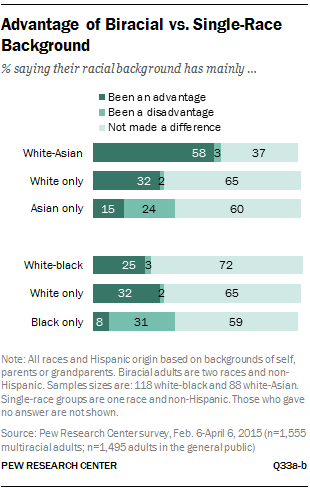 Multiracial Americans, for the most part, don’t think having a racial background that includes more than one race has been an advantage or a disadvantage in their life. But to the extent that it has mattered, more say their racial background has been beneficial than say it has been detrimental. This is particularly the case among biracial adults who are white and Asian.
Multiracial Americans, for the most part, don’t think having a racial background that includes more than one race has been an advantage or a disadvantage in their life. But to the extent that it has mattered, more say their racial background has been beneficial than say it has been detrimental. This is particularly the case among biracial adults who are white and Asian.
Overall, about one-in-five (19%) adults with a mixed racial background say being multiracial has been mainly an advantage, while just 4% say it has been a disadvantage; 76% say it has not made a difference.
Biracial adults who are white and Asian are far more likely than any other biracial group to say their mixed racial background has been mainly an advantage. About six-in-ten (58%) of those who are white and Asian say this, compared with 25% of those who are white and black, 14% of those who are white and American Indian, and 10% of those who are black and American Indian. About one-in-five (22%) of those who are white, black and American Indian say their racial background has mainly been an advantage. Majorities of adults who are white and black (72%), white and American Indian (82%), black and American Indian (89%), and white, black and American Indian (76%) say it has been neither an advantage nor a disadvantage.
In addition to having a more positive view of the impact of their racial background than other biracial adults, those who are both white and Asian are more likely than single-race whites and single-race Asians to say their racial background has been mainly an advantage in their lives. About a third (32%) of single-race whites say their racial background has mainly had a positive impact, 26 percentage points lower than among the white and Asian biracial group. The contrast is even more pronounced between those who are both white and Asian and single-race Asians: only 15% of single-race Asians say their racial background has been mainly an advantage (43 percentage points lower than among the white and Asian group), while about a quarter (24%) say it has mainly been a disadvantage.
Similarly, biracial adults who are white and black have a more positive view of the impact of their racial background than do single-race blacks. While those who are both white and black are far more likely to say it has been an advantage (25%) than to say it has been a disadvantage (3%) in their lives, the opposite is true among single-race blacks. About three-in-ten (31%) say their racial background has had a negative impact on their lives vs. 8% who say it has had a positive impact. Assessments of the overall impact of their racial background do not different significantly between those who are both white and black and those who are white only.
Most Have Felt Proud of Multiracial Background
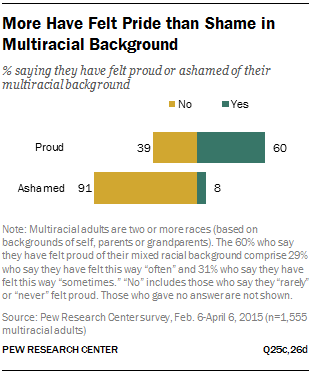 A majority (60%) of multiracial adults say they have at times felt pride in their mixed racial background, a sentiment that is shared by about a half or more across multiracial groups. Three-quarters of those who are white and Asian say they are proud of having a racial background that includes more than one race, as do 64% of white and black, 57% of white and American Indian, and 54% of black and American Indian biracial adults; about half (53%) of multiracial adults who are white, black and American Indian also say they have felt this way.
A majority (60%) of multiracial adults say they have at times felt pride in their mixed racial background, a sentiment that is shared by about a half or more across multiracial groups. Three-quarters of those who are white and Asian say they are proud of having a racial background that includes more than one race, as do 64% of white and black, 57% of white and American Indian, and 54% of black and American Indian biracial adults; about half (53%) of multiracial adults who are white, black and American Indian also say they have felt this way.
Hispanics who are two or more races are considerably more likely than non-Hispanic multiracial adults to say they have been proud of their mixed racial background, although majorities among both groups say this has happened to them. About three-quarters (76%) of multiracial Hispanics say this, compared with 58% of multiracial adults who are not Hispanic.
In contrast, just 8% of multiracial adults say they have ever felt embarrassed or ashamed of their mixed racial background. Feelings of shame are more common among those who have been treated badly or have experienced some form of discrimination because they are multiracial. For example, those who say a relative or someone in their extended family has treated them badly are four times as likely as those who have not experienced this to say they have felt embarrassed or ashamed of being multiracial (24% vs. 6%).
Many Feel They Are More Open to Other Cultures and Races
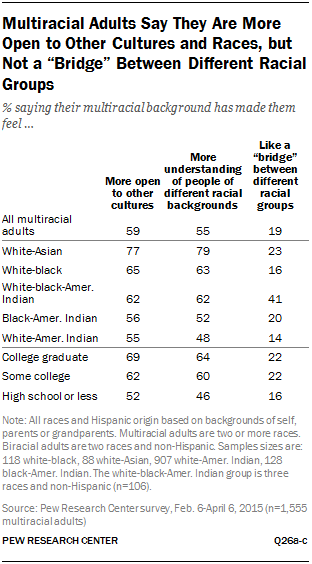 The survey findings suggest that multiracial adults may have a more open and understanding approach to people of other races and cultures. About six-in-ten (59%) multiracial Americans believe their mixed racial background has made them more open to cultures other than their own, and about as many (55%) have felt that they are more understanding of people of different racial backgrounds. This is especially the case among multiracial adults who have attended college: 69% of college graduates and 62% of those with some college say they have felt that they are more open to other cultures, and 64% and 60%, respectively, have felt that they are more understanding of people of different racial backgrounds. By comparison, of those with less education, 52% say they are more open to other cultures and 46% say they are more understanding of people of different racial backgrounds.
The survey findings suggest that multiracial adults may have a more open and understanding approach to people of other races and cultures. About six-in-ten (59%) multiracial Americans believe their mixed racial background has made them more open to cultures other than their own, and about as many (55%) have felt that they are more understanding of people of different racial backgrounds. This is especially the case among multiracial adults who have attended college: 69% of college graduates and 62% of those with some college say they have felt that they are more open to other cultures, and 64% and 60%, respectively, have felt that they are more understanding of people of different racial backgrounds. By comparison, of those with less education, 52% say they are more open to other cultures and 46% say they are more understanding of people of different racial backgrounds.
White and Asian biracial adults are more likely than other multiracial groups to say their mixed racial background has made them more open to other cultures and more understanding of people with different racial backgrounds: About three-quarters of biracial adults who are white and Asian say this is the case. Somewhat fewer of those who are white and American Indian or black and American Indian say they have felt more open to cultures other than their own because of their mixed racial background (55% and 56%, respectively), and about half in each group say they have felt like they are more understanding of people of different racial backgrounds (48% and 52%, respectively). Fully 65% of biracial adults who are white and black believe their mixed racial background has made them more open to other cultures. A similar share (62%) of multiracial adults who are white, black and American Indian say the same. Similarly, fully 63% of multiracial adults who are white and black and 62% who are white, black and American Indian say they are more understanding of people of different racial backgrounds.
I think some of the benefits of being multiracial [are] that you have an understanding about multiple cultures and a familiarity and appreciation for them.White and Asian biracial man, age 44
Yet, while many say their mixed racial background has made them more open to other cultures and more understanding of different racial backgrounds, relatively few multiracial adults see themselves as ambassadors who can bring people of different races together. Just 19% say they have ever felt like a go-between, or “bridge,” between different racial groups, while 80% have not felt this way. Even among those who say being multiracial has made them more open to other cultures or more understanding of people of different racial backgrounds, only about three-in-ten have felt like they were a bridge between different racial groups.
“What Are You?”
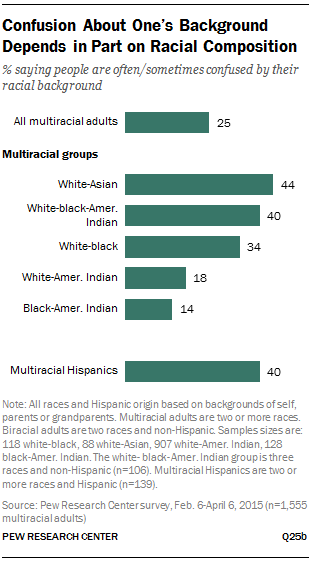 A quarter of multiracial adults report that people are often or sometimes confused about their racial background, and that is particularly the case among those who are white and Asian (44%), white and black (34%) and white, black and American Indian (40%). In contrast, just 18% of white and American Indian and 14% of black and American Indian biracial adults say this happens at least sometimes.
A quarter of multiracial adults report that people are often or sometimes confused about their racial background, and that is particularly the case among those who are white and Asian (44%), white and black (34%) and white, black and American Indian (40%). In contrast, just 18% of white and American Indian and 14% of black and American Indian biracial adults say this happens at least sometimes.
Hispanic multiracial adults are also more likely than those who are not Hispanic to say people are confused about their racial background. Four-in-ten adults who are Hispanic and two or more races say this happens at least sometimes, compared with 23% of multiracial adults who are not Hispanic.
Among those who say people are often or sometimes confused about their racial background, 62% say they have felt annoyed because someone made assumptions about their race. Just about one-in-ten (11%) multiracial adults who say people are rarely or never confused have felt annoyed by this. Overall, 24% of multiracial Americans say they have felt annoyed at times because someone made assumptions about their racial background.
Few Have Felt Like an Outsider
About one-in-eight (12%) multiracial adults say they have at least sometimes felt like an outsider because of their mixed racial background; 71% say they have never felt this way, and 14% say they have, but only rarely.
Multiracial adults who are white and American Indian (83%) or black and American Indian (77%) are far more likely than those who are white, black and American Indian (62%), white and black (56%) or white and Asian (48%) to say they have never felt like an outsider because of their racial background. Across all of these multiracial groups, three-quarters or more say this has happened rarely, if at all.
Among Hispanic adults who are two or more races, half say they have never felt like an outsider because they are multiracial, and an additional 31% say they have rarely felt that way. About one-in-five (19%) say they have felt like an outsider at least sometimes because of their mixed racial background. In contrast, about three-quarters (74%) of non-Hispanic multiracial adults have never felt like an outsider because of their mixed racial background, 14% say they have felt that way only rarely and 11% say they have felt like an outsider at least sometimes.
Experiences with Discrimination Often Tied to Racial Perceptions
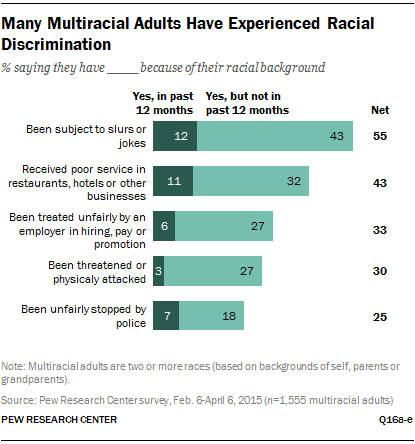 Fully 55% of multiracial adults report that they have been subject to slurs or jokes because of their racial background; smaller but substantial numbers also say they have received poor service in restaurants, hotels or other businesses (43%), been treated unfairly by an employer in hiring, pay or promotion (33%), been threatened or physically attacked (30%), or been unfairly stopped by police (25%).
Fully 55% of multiracial adults report that they have been subject to slurs or jokes because of their racial background; smaller but substantial numbers also say they have received poor service in restaurants, hotels or other businesses (43%), been treated unfairly by an employer in hiring, pay or promotion (33%), been threatened or physically attacked (30%), or been unfairly stopped by police (25%).
Multiracial adults with a black background are far more likely than those who are white and Asian or white and American Indian to say they have experienced some forms of discrimination because of their racial background. In particular, about six-in-ten or more adults who are white and black (57%), white, black and American Indian (74%) and black and American Indian (67%) say they have received poor service in restaurants, hotels or other businesses. Far fewer adults who are white and American Indian (30%) or white and Asian (25%) say they’ve experienced this. Similarly, multiracial adults who say one of their races is black are much more likely than those without a black background to say they have been treated unfairly by an employer or unfairly stopped by police.
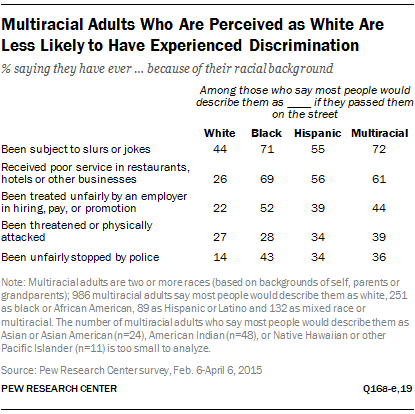 Across most items measured, experiences with racial discrimination are, at least in part, tied to the way one’s racial background is perceived by others. For example, half or more of those who say most people who pass them on the street would describe them as black (69%), multiracial (61%) or Hispanic (56%) say they have received poor service at restaurants, hotels or other businesses; only about half that share (26%) of multiracial adults who say most would describe them as white have experienced this. Those who are perceived as white are also less likely to say they have been treated unfairly by an employer or have been unfairly stopped by police; and less likely than those who are seen as black or multiracial to have been subject to slurs or jokes.
Across most items measured, experiences with racial discrimination are, at least in part, tied to the way one’s racial background is perceived by others. For example, half or more of those who say most people who pass them on the street would describe them as black (69%), multiracial (61%) or Hispanic (56%) say they have received poor service at restaurants, hotels or other businesses; only about half that share (26%) of multiracial adults who say most would describe them as white have experienced this. Those who are perceived as white are also less likely to say they have been treated unfairly by an employer or have been unfairly stopped by police; and less likely than those who are seen as black or multiracial to have been subject to slurs or jokes.
In some instances, experiences with racial discrimination among those who are perceived to be a certain race mirror those of single-race adults of that race. For example, 28% of multiracial adults who say most people would described them as black if they passed them on the street say they have been threatened or physically attacked because of their racial background, as do 25% of single-race blacks; about four-in-ten multiracial adults who are perceived as black (43%) and single-race blacks (42%) report having been unfairly stopped by police; and 52% of multiracial adults who are seen as black and 46% of those who are single-race black say they have been treated unfairly by an employer. Likewise, multiracial adults who are perceived as white generally report facing discrimination at rates similar to those for single-race whites.
I don’t care how many races I have. I’m looked at as an African American. And because of that, I’m already in the back seat of a car.Black and Asian biracial man, age 47
It wasn’t until college until I began to be exposed to ideas of institutional racism, institutional oppression, that I began to realize actually I don’t get the benefit from white privilege, and that people, no matter how I see myself, at the end of the day I’m still black.White and black biracial man, age 25
It is notable, however, that multiracial adults who are perceived as black or white are more likely than single-race blacks and whites, respectively, to say they have been subjected to racially motivated slurs or jokes. About seven-in-ten (71%) multiracial adults who say most would describe them as black say this has happened to them, compared with 56% of single-race blacks who say the same. And while 44% of multiracial adults who are seen as white say they have been subject to slurs or jokes because of their racial background, fewer single-race whites (36%) say this has happened to them.
For some multiracial adults, especially those who are white and black and white and Asian, racially motivated jokes or insults started in childhood. About one-in-seven (15%) multiracial adults, including similar shares across age groups, say they were at times teased or made fun of when they were growing up because of their mixed racial background. Those who are white and black (28%) and white and Asian (30%) are about three times as likely as those who are white and American Indian (10%), white, black and American Indian (10%) or black and American Indian (11%) to say they were teased as children because of their mixed racial background.
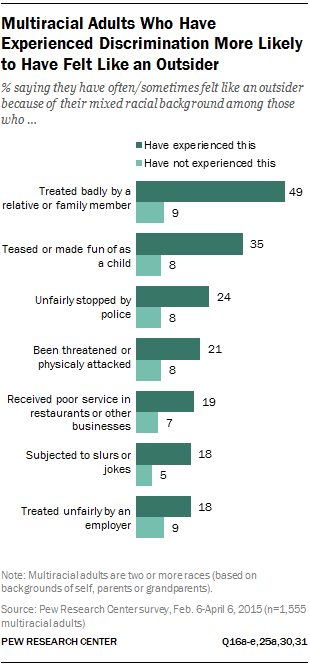 For those who have experienced some form of rejection or discrimination, feeling like an outsider is not uncommon. For example, about half (49%) of multiracial adults who say they have been treated badly by a member of their extended family because of their mixed racial background say they have felt like an outsider at times; just 9% of those who have not been mistreated by a family member say the same.
For those who have experienced some form of rejection or discrimination, feeling like an outsider is not uncommon. For example, about half (49%) of multiracial adults who say they have been treated badly by a member of their extended family because of their mixed racial background say they have felt like an outsider at times; just 9% of those who have not been mistreated by a family member say the same.
Among multiracial adults who say they were at least sometimes teased when they were growing up because of their mixed racial background, 35% report that they have, at times, felt like an outsider, compared with 8% of those who say they were rarely or never teased. Smaller but significant differences in feelings of exclusion are also evident based on whether a person had ever been threatened or physically attacked because of their racial background; subject to slurs or jokes; treated unfairly by an employer; received poor service at restaurants and other businesses; or unfairly stopped by police.
Talking to Parents and Children About Racial Background
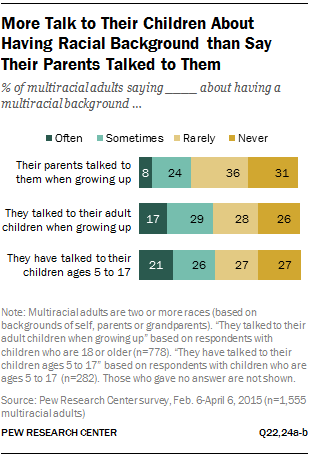 A larger share of multiracial adults say they talk to their own children about having a mixed racial background than say their parents talked to them about it when they were growing up. About a third (32%) of multiracial adults say their parents talked to them at least sometimes about having a mixed racial background when they were growing up; 36% say this happened only rarely, and 31% say their parents never talked to them about this topic.
A larger share of multiracial adults say they talk to their own children about having a mixed racial background than say their parents talked to them about it when they were growing up. About a third (32%) of multiracial adults say their parents talked to them at least sometimes about having a mixed racial background when they were growing up; 36% say this happened only rarely, and 31% say their parents never talked to them about this topic.
Older multiracial adults are less likely to say their parents talked to them at least sometimes about having a mixed racial background. About four-in-ten (38%) of mixed-race adults younger than 30 say their parents did this, compared with about a quarter (23%) of those ages 65 and older.
By comparison, more than four-in-ten (46%) multiracial parents of adult children say they talked to their own children at least sometimes when they were growing up about having a mixed racial background; about the same share (47%) of those with children ages 5 to 17 say they have talked to their children about this.
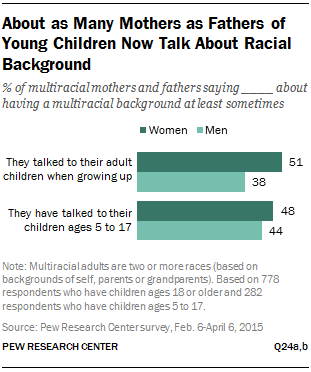 Multiracial mothers of adult children are more likely than fathers to say they talked to their children about their racial heritage when they were growing up (51% vs. 38%, respectively). Among multiracial parents of children ages 5 to 17, however, about as many mothers (48%) as fathers (44%) say they sometimes talk to their children about their mixed racial background.
Multiracial mothers of adult children are more likely than fathers to say they talked to their children about their racial heritage when they were growing up (51% vs. 38%, respectively). Among multiracial parents of children ages 5 to 17, however, about as many mothers (48%) as fathers (44%) say they sometimes talk to their children about their mixed racial background.
About one-in-six (16%) multiracial parents with children of any age say someone at some point has assumed they were not their child’s parent because the person thought they and the child had different racial backgrounds. For the most part, mothers and fathers, as well as parents across age, income and educational groups, are about equally as likely to say this has happened to them.
Growing up [my mother] always would talk to us about, ‘What it means to be Catawba? What does it mean if you don’t look like what most people think Native Americans look like? What does it mean for the people who do look like what most people think Native Americans should look like?’White and American Indian biracial man, age 23
Most Are Satisfied with Key Aspects of Life
About eight-in-ten (81%) multiracial adults are satisfied with the way things are going in their life, including 29% who say they are very satisfied. At least eight-in-ten also express satisfaction with their family life (87%), the number of friends they have (83%) and the quality of life in their community (80%).
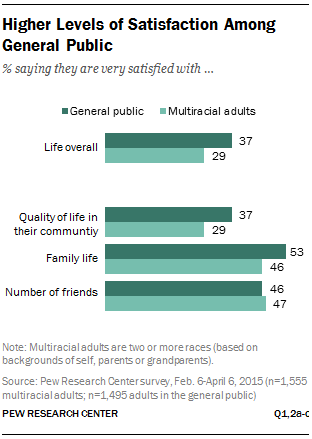 Compared with the general public, multiracial adults are about as likely to say they are at least somewhat satisfied with life overall and with some key aspects of it. But more among the general public express high levels of satisfaction. For example, while 29% of multiracial Americans say they are very satisfied with the way things are going in their life and with the quality of life in their community, 37% of all Americans say the same about each of these items. The general public is also more likely than multiracial adults to express high levels of satisfaction with their family life; 53% and 46%, respectively, are very satisfied with this aspect of their life. These differences reflect, at least in part, the fact that the general public tends to be older than the multiracial population, and older adults express higher levels of satisfaction with some aspects of life than do younger people.
Compared with the general public, multiracial adults are about as likely to say they are at least somewhat satisfied with life overall and with some key aspects of it. But more among the general public express high levels of satisfaction. For example, while 29% of multiracial Americans say they are very satisfied with the way things are going in their life and with the quality of life in their community, 37% of all Americans say the same about each of these items. The general public is also more likely than multiracial adults to express high levels of satisfaction with their family life; 53% and 46%, respectively, are very satisfied with this aspect of their life. These differences reflect, at least in part, the fact that the general public tends to be older than the multiracial population, and older adults express higher levels of satisfaction with some aspects of life than do younger people.
For the most part, outlooks on key aspects of life don’t vary considerably across racial groups, but those who are white and Asian express far more positive views about the quality of life in their community than do other biracial adults. About half (48%) of white and Asian adults say they are very satisfied with this aspect of their life, compared with about a third or fewer white, black and American Indian (32%), white and American Indian (30%), white and black (27%) and black and American Indian (23%) adults.
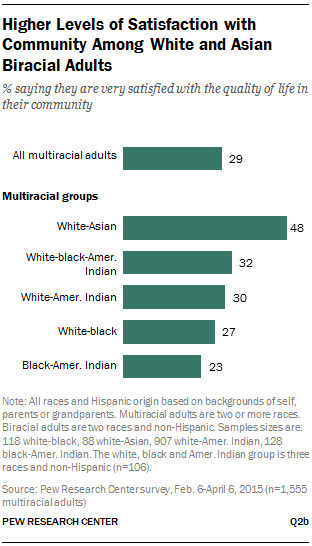 Across most measures, multiracial adults with a black background are less likely than single-race blacks to express high levels of satisfaction. The difference is especially pronounced when it comes to family life and quality of life in one’s community. About half (53%) of adults who are black are very satisfied with their family life, compared with 41% of multiracial adults with a black background. And while fewer than half among both groups are very satisfied with the quality of life in their community, single-race blacks are more likely than multiracial adults with a black background to express high levels of satisfaction (38% vs. 25%). Again, these differences reflect, at least in part, the fact that multiracial population tends to be younger than single-race groups.
Across most measures, multiracial adults with a black background are less likely than single-race blacks to express high levels of satisfaction. The difference is especially pronounced when it comes to family life and quality of life in one’s community. About half (53%) of adults who are black are very satisfied with their family life, compared with 41% of multiracial adults with a black background. And while fewer than half among both groups are very satisfied with the quality of life in their community, single-race blacks are more likely than multiracial adults with a black background to express high levels of satisfaction (38% vs. 25%). Again, these differences reflect, at least in part, the fact that multiracial population tends to be younger than single-race groups.
Similarly, adults who are white are more likely than multiracial adults with a white background to say they are highly satisfied with the quality of life in their community (39% vs. 30%), and single-race whites are also more likely to say they are very satisfied with life overall (37% vs. 31% of multiracial adults with a white background). Single-race Asians are also more likely than multiracial adults with an Asian background to say they are very satisfied with the way things are going in their life (35% vs. 24%), but the two groups do not differ significantly in their outlook on family life, quality of life in their community, or the number of friends they have.
Views of Personal Finances
Compared with the general public, multiracial adults are somewhat less likely to describe themselves as upper class and more likely to say they are lower class.46 About half of each group self-identify as middle class. Among multiracial adults, about four-in-ten (38%) say they are in the lower class and 11% describe themselves as upper class. By comparison, 32% of the general public self-identify as lower class and 16% say they are upper class.
When asked to describe their household’s financial situation, multiracial adults are also less likely than the general public to say they live comfortably (24% vs. 31%). Roughly the same shares in each group say they meet their basic expenses with a little left over for extras (43% and 40%, respectively), just meet their basic expenses (23% and 20%), or don’t even have enough to meet basic expenses (8% in each group). Descriptions of household finances, as well as social class identification, don’t vary significantly across different multiracial groups.


 Learn About the U.S. Census in our Email Mini-Course
Learn About the U.S. Census in our Email Mini-Course Multiracial American Voices
Multiracial American Voices